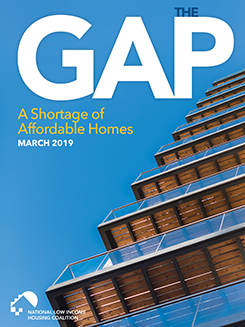NLIHC Gap 2019 Report Calls for Significant Investments to Address Shortage of 7 Million Affordable and Available Homes for the Lowest-Income Households
Mar 18, 2019
 NLIHC released The Gap: A Shortage of Affordable Homes 2019 on March 14. The report finds a shortage of 7 million affordable and available rental homes for households with extremely low incomes at or below the poverty guideline or 30% of the area median income (AMI), whichever is higher. Seventy-one percent of extremely low-income households are severely housing cost-burdened, spending more than half of their incomes on housing. Extremely low-income renters are more likely to be severely housing cost-burdened than any other income group, accounting for 73% of all severely housing cost-burdened renters in the U.S. The report calls for a significant and sustained federal commitment to affordable housing programs targeted at the lowest-income renters.
NLIHC released The Gap: A Shortage of Affordable Homes 2019 on March 14. The report finds a shortage of 7 million affordable and available rental homes for households with extremely low incomes at or below the poverty guideline or 30% of the area median income (AMI), whichever is higher. Seventy-one percent of extremely low-income households are severely housing cost-burdened, spending more than half of their incomes on housing. Extremely low-income renters are more likely to be severely housing cost-burdened than any other income group, accounting for 73% of all severely housing cost-burdened renters in the U.S. The report calls for a significant and sustained federal commitment to affordable housing programs targeted at the lowest-income renters.
The shortage of affordable and available homes is most acute for renters with extremely low incomes. Only 37 affordable and available homes exist for every 100 extremely low-income renter households. As a result, 7.8 million of the 11 million extremely low-income renter households in the U.S. are severely housing cost-burdened. By comparison, 2.1 million very low-income renter households (with incomes between 31% and 50% of AMI) and 684,000 low-income renter households (with incomes between 51% and 80% of AMI) are severely cost-burdened.
No state or major metropolitan area has an adequate supply of affordable and available homes for renters with extremely low incomes. Nevada has the lowest relative supply, with only 19 affordable and available homes for every 100 extremely low-income renter households, while Wyoming has the greatest supply with 66 for every 100.
Twenty-six percent of extremely low-income renter households are seniors, 22% are householders with disabilities, and 39% are in the labor force. Others are in school or are caregivers of a young child or of a household member with a disability. Twenty percent of black households, 18% of American Indian or Alaska Native households, and 16% of Hispanic households are renters with extremely low incomes, compared to just 6% of white non-Hispanic households.
NLIHC calls for greater federal investments in housing programs for the lowest-income people in the U.S, including the national Housing Trust Fund, the Housing Choice Voucher program, and public housing. NLIHC also encourages reforms to the federal tax code like expansion and reform of the Low Income Housing Tax Credit and a renters’ tax credit targeted to renters with the lowest incomes.
Join NLIHC for a Twitter chat about the severe shortage of affordable and available rental homes for the nation’s lowest-income renters and about practical solutions at 3:00 p.m. ET on Thursday, March 21. Follow the discussion using #TheGap19 and share questions for the authors.
The Gap: A Shortage of Affordable Homes 2019 is available at: https://reports.nlihc.org/gap.